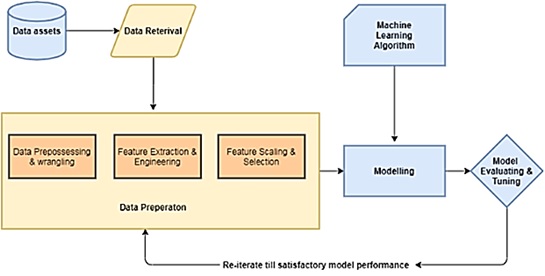Visualizing Impact of Weather on Traffic Congestion Prediction: A Quantitative Study
DOI:
https://doi.org/10.33411/ijist/2021030517Keywords:
Gradient Boosting; Decision Tree Algorithm; Supervised Machine Learning; Traffic CongestionAbstract
A substantial amount of research has been done to develop improved Intelligent Transportation Systems (ITS) to alleviate traffic congestion problems. These include methods that incorporate the indirect impact on traffic flow such as weather. In this paper, we studied the impact of weather conditions on traffic congestion along with more spatial and temporal factors, such as weekdays/time and location, which is a different approach to this problem. The proposed solution uses all these indicators to estimate the flow of traffic. We evaluate the level of congestion (LOC) based on the traffic volume grouped in certain regions of the city. The index for the defined LOC indicates the traffic flow from “free -flowing” to “traffic jam”. The data for the traffic volume count is collected from the Department of Transportation (DOT) for NYMTC. Weather conditions along with special and temporal information have an essential role in predicting the congestion level. We used supervised machine learning for this purpose. The prediction models are based on certain factors such as the volume count of the traffic at the entry and exit point of each street pair, particular days of the week, timestamp, geographical location, and weather parameters. The study is done on the major roadways of each of the four prominent boroughs in New York. The results of the traffic prediction model were established by using the Gradient Boosting Regression Tree (GBRT) which showed an accuracy of 97.12%. Moreover, the calculation speed was relatively fast, and it has stronger applicability to the prediction of congestion conditions.
References
Sweet, M. “Traffic Congestion’s Economic Impacts: Evidence from US Metropolitan Regions”. 2013 SAGE journals-Urban Studies, vol. 51, pp. 2088-2110, 2013
Thianniwet, Thammasak & Phosaard, Satidchoke & Pattara-atikom, Wasan. “Classification of Road Traffic Congestion Levels from GPS Data using a Decision Tree Algorithm and Sliding Windows”. 2009 World Congress on Engineering, vol. 1, 2009
Jahangiri, A., &Rakha, H. A. “Applying Machine Learning Techniques to Transportation Mode Recognition Using Mobile Phone Sensor Data”. IEEE Transactions on Intelligent Transportation Systems, vol. 16, pp. 2406–2417, 2018
Jayapal, C., & Roy, S. S. “Road traffic congestion management using VANET”, 2016 International Conference on Advances in Human Machine Interaction (HMI), 2016
P. Chhatpar, N. Doolani, S. Shahani, and R. Priya, “Machine learning solutions to vehicular traffic congestion,” 2018 International Conference on Smart City and Emerging Technology (ICSCET), 2018.
Y. Liu and H. Wu, “Prediction of road traffic congestion based on random forest,” 2017 10th International Symposium on Computational Intelligence and Design (ISCID), vol. 2, 2017
Chowdhury, B.,Kinhikar, M. &Alleema, N. N. “Road Traffic Prediction using Machine Learning”. International Research Journal of Engineering and Technology (IRJET). Vol. 06, 2019
M. M. Chowdhury, M. Hasan, S. Safait, D. Chaki, and J. Uddin, “A traffic congestion forecasting model using cmtf and machine learning,” 2018 Joint 7th International Conference on Informatics Electronics and Vision (ICIEV) and 2018 2nd International Conference on Imaging, Vision and Pattern Recognition (icIVPR), 2018
Huang, F.-R., Wang, C.-X., & Chao, C.-M. “Traffic Congestion Level Prediction Based on Recurrent Neural Networks”. 2020 International Conference on Artificial Intelligence in Information and Communication (ICAIIC), 2020
Jia Lu, & Li Cao. “Congestion evaluation from traffic flow information based on fuzzy logic”. 2003 IEEE International Conference on Intelligent Transportation Systems., 2003
Sun Ye. “Research on Urban Road Traffic Congestion Charging Based on Sustainable Development”. International Conference on Applied Physics and Industrial Engineering, Physics Procedia 24 pp. 1567–1572, 2012
Ge Shi, Jie Shan, Liang Ding, Peng Ye, Yang Li, Nan Jiang. “Urban Road Network Expansion and Its Driving Variables: A Case Study of Nanjing City”. International Journal of Environmental Research and Public Health, 16, pp. 2318, 2019
Gao ZH, Chen ZJ, Liu YX, Huang K (2007) Study on the complex network characteristics of urban road system based on GIS. Proceedings of SPIE 6754:67540N
S R Samal1, P Gireesh Kumar2, J Cyril Santhosh3, and M Santhakumar. “Analysis of Traffic Congestion Impacts of Urban Road Network under Indian Condition”. IOP Conf. Series: Materials Science and Engineering, 2020
Z. Yin, J. Wang and H. Lu, “A Study on Urban Traffic Congestion Dynamic Predict Method Based on Advanced Fuzzy Clustering Model,” 2008 International Conference on Computational Intelligence and Security, 2008, pp. 96-100, doi: 10.1109/CIS.2008.194.
Jarašūnienė, Aldona. (2007). Research into Intelligent Transport Systems (ITS) technologies and efficiency. TRANSPORT. 22. 61-67, 2010
Wei-Hsun Lee and Chi-Yi Chiu. “Design and Implementation of a Smart Traffic Signal Control System for Smart City Applications”. Sensors 2020, 20, 508; doi:10.3390/s20020508
Sarker, I.H. Machine Learning: Algorithms, Real-World Applications and Research Directions. SN COMPUT. SCI. 2, 160 (2021). https://doi.org/10.1007/s42979-021-00592-x
Abdulraheem, Ajiboye & Abdullah Arshah, Ruzaini & Qin, Hongwu. (2015). Evaluating the Effect of Dataset Size on Predictive Model Using Supervised Learning Technique. International Journal of Software Engineering & Computer Sciences (IJSECS). 1. 75-84. 10.15282/ijsecs.1.2015.6.0006.

Published
How to Cite
Issue
Section
License
Copyright (c) 2022 50Sea

This work is licensed under a Creative Commons Attribution 4.0 International License.




















